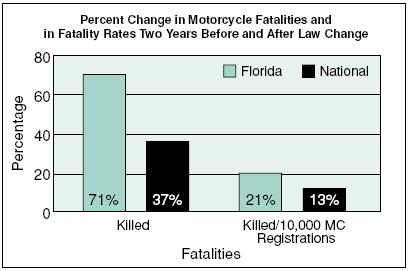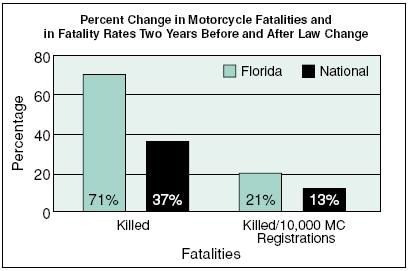















Traffic Tech #299: Florida's Motorcycle Helmet Law Repeal |
|---|
|

On July 1, 2000, Florida repealed the legal requirement that all motorcyclists wear protective helmets. State law now requires helmet use only by riders under the age of 21, and by older riders who do not have a minimum of $10,000 medical insurance coverage.
The National Highway Traffic Safety Administration (NHTSA) contracted with Preusser Research Group to evaluate the effects of the motorcycle helmet law repeal in Florida.

Helmet Use - Observational Surveys
Virtually all observed riders were wearing helmets in a 1998 Florida helmet use observation survey. Only 65 percent of the observed sample, however, wore compliant helmets (helmets that meet the requirements for Federal Motor Vehicle Safety Standard No. 218) while 35 percent were wearing noncompliant helmets (headgear that does not meet Federal Motor Vehicle Safety Standard No. 218). These weighted figures compare to 84 percent approved helmets and 15 percent noncompliant helmets observed in a 1993 survey that noncompliant helmet use was increasing over time.
A 2002 post-law change survey found 47 percent compliant helmet use, 6 percent noncompliant helmet use and 47 percent no helmet use. These results indicate that use of compliant helmets has declined significantly following the law change while wearing noncompliant helmets has largely been abandoned.
Helmet Use - Crash Reports
Among the 515 motorcyclists killed in traffic crashes in the 3 years before the helmet law change (1997-1999), 9 percent were recorded in the Fatality Analysis Reporting System (FARS) as not wearing a helmet. In the 3 years following the law change (2001-2003), 61 percent of the 933 fatally injured motorcyclists were reported as not wearing a helmet. In 1997-1999, there were 35 motorcyclists under the age of 21 killed in Florida. Of these, 26 percent were not helmeted. In 2001-2003, 101 motorcyclists under age 21 were killed (+ 188 percent) with 45 percent of them not wearing a helmet.
Motorcyclist Fatalities (note 1)
There has been a substantial increase in motorcyclists killed in Florida beginning in the first 6 months of 2000 (the repeal of the all-rider helmet law went into effect on July 1, 2000). Fatalities in the two years following the law change (2001-2002, N=575) were 71 percent greater than the two years before the law change. This is almost double the increase in fatalities for the nation as a whole. Fatalities in Florida per 10,000 registered motorcycles increased 21 percent compared to 13 percent nationally for the 2 years before and after the law change - 75 percent higher than the national rate.
There was an average of 181 motorcyclists killed annually in the 30 months before the law change, and an average of 280 in the 30 months after the law change. Registrations increased an average 33.7 percent in this time period in Florida (219,486 to 293,393). The expected average annual number of motorcycle fatalities as a result of the increase in registrations was 242. The actual number who died in 2002 was 301, 24 percent (59) more motorcycle fatalities than expected as a result of increased registrations alone. The actual number who died in 2003 was 358.

When the increase in motorcycle registrations after the law change is taken into account, the unhelmeted fatality rate per 10,000 registered motocycles increased from 0.7 fatalities in 1998 to 6.1 fatalities in 2002. The rate for helmeted motorcyclist fatalities, on the other hand, fell from 7.6 in 1998 to 3.2 in 2002.
Note 1 - All fatality numbers used in this study are based on FARS vehicle body type code 80 only in order to maintain consistency with the other data sources used such as the Florida motor vehicle crash database. In contrast, NHTSA typically uses FARS body type codes 80-89 when discussing motorcycle crashes. Thus, in its publications about motorcycles (for example, Traffic Safety Facts) NHTSA fatality numbers will differ slightly from the numbers and rates reported in this study. These small differences in no way alter the findings or implications of the results.
Motorcyclist Injuries
The Florida Department of Highway Safety and Motor Vehicles produces an annual database of information taken from police motor vehicle crash reports. In the first full year following the law change (2001), there were 1,890 motorcyclists who sustained incapacitating injury and 3,886 who sustained lesser injury. These figures are 32 percent and 28 percent higher, respectively, than the comparable figures in 1999. Injuries per 10,000 registered motorcycles increased in 2000, but decreased in 2001. Although the injury rate per registered motorcycle in 2001 is less than the rate in 1999, the previous downward trend of non-fatal injuries per registered motorcycle appears to have slowed following the law change.
Hospital Discharge Data
The Hospital Discharge database maintained by the Florida Agency for Health Care Administration shows that in the 30 months immediately following the helmet law change, there were 4,986 motorcyclists admitted to hospitals for acute care treatment. This figure is 40 percent greater than the 3,567 admissions during the 30 months just before the law change. Head injury admissions increased by more than 80 percent.
Total gross costs charged to hospital admitted motorcyclists with head, brain or skull injury more than doubled from $21 million to $44 million, adjusted for inflation, and the average cost per case rose from $34,518 to $39,877 in the 30 months after the law change. In 1998 and 1999, the acute care hospital charges for head-brain-skull principal injury cases per 10,000 registered motorcycles were $311,549 and $428,347 respectively. The comparable figures for 2001 and 2002 were $605,854 and $610,386, adjusted for inflation.
In the post law change period, 75 percent of the head, brain, skull injured admitted motorcyclists were charged approximately $12,000 or more while the remaining 25 percent of patients were charged less than this amount. That is, less than one-quarter of the injured would be covered by the $10,000 medical insurance requirement for those who chose not to use helmets. The hospital discharge data indicate that in the post law change period, approximately 63 percent of admitted motorcyclists were covered by commercial insurance ($31 million), 16 percent were classified as "self pay" because they were under insured or uninsured ($8 million), while the remaining 21 percent had their costs ($10.5 million) billed to charitable and public sources (e.g., Medicaid).
Limitations of the Study
National data suggest that as motorcycle registrations increase, motorcyclists' deaths and injuries increase. In Florida, motorcycle registrations increased substantially beginning in the year of the repeal of the all-rider helmet law, an outcome seen in other states that repealed helmet laws in recent years. The increases in motorcycle registrations alone do not account for the size of the increases in fatalities or the hospital admissions for head injuries. The decline in helmet use contributed significantly to the increase in deaths and head injuries. Other factors that may have contributed to the fatality increase are alcohol use, speed, increased exposure, and the likely contribution of a change in motorcycle ridership.
Nationally, motorcycle vehicle miles of travel (VMT) increased gradually throughout the 1990s, but decreased in 2001 and 2002. The VMT measure, provided by the Federal Highway Administration, is regarded as a good indicator of trends year to year, but cannot be broken down reliably to the individual state level for motorcycles.
Head-Brain-Skull Injury Treatment Costs
|
Period
|
Number
of Cases |
Costs*
|
Total
Costs* |
Average
Case Cost* |
|---|---|---|---|---|
|
1998
1999 2000 pre |
188
263 151 |
$6,460,620
$9,463,172 $4,845,147 |
Pre Law
(30 Months) $20,779,939 |
Pre Law
(30 Months) $34,581 |
|
2000 post
2001 2002 |
178
445 474 |
$6,455,558
$17,555,237 $19,733,833 |
Post Law
(30 Months) $43,744,629 |
Post Law
(30 Months) $39,877 |
* Adjusted by Consumer Price Index (DOL) for medical care, 1999-2002, expressed in 1998 dollars.
Source: Florida Agency for Health Care Administration, Department of Labor
In 1998, the average motorcycle traveled 2,645 miles, while in 2002 this figure had declined to 1,909 miles.
Summary
The effects of Florida's repeal of its all-rider motorcycle helmet use law are similar to those seen in the other states that have repealed such laws (Arkansas, Kentucky, Louisiana, Texas).
How To Order
For a copy of Evaluation of the Repeal of the All-Rider Motorcycle Helmet Law In Florida (30 pages) write to the Office of Research and Technology, NHTSA, NTI-130, 400 Seventh Street, SW., Washington D.C. 20590 or send a fax to (202) 366-7096 or download www.nhtsa.dot.gov. Patty Ellison-Potter, Ph.D. was the contract manager.
|
TRAFFIC TECH is a publication to disseminate information about traffic safety programs, including evaluations, innovative programs, and new publications. Feel free to copy it as you wish. If you would like to receive a copy, contact Melissa Cheung, MPH, Editor, fax 202-366-7096, e-mail: melissa.cheung@dot.gov. |
